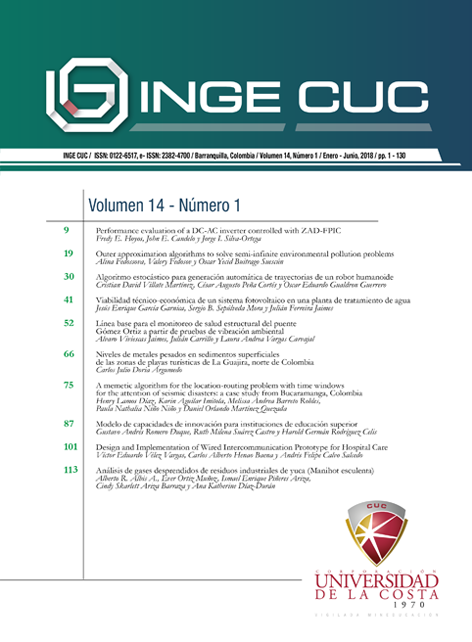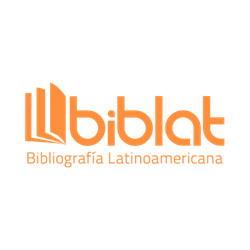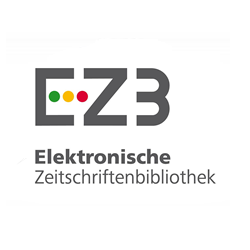Technical and economic feasibility study of implementing a photovoltaic system in a water treatment plant
DOI:
https://doi.org/10.17981/ingecuc.14.1.2018.04Keywords:
Feasibility, Photovoltaic energy, solar energy, Electrical lighting, Feasibility studies.Abstract
Introduction: Illumination systems based on sodium and mercury vapor lamps are inefficient and consume a big amount of electrical energy. LED lamps represent an attractive alternative to decrease electricity consumption. On the other hand, photovoltaic systems are being utilized as a renewable energy source to reduce CO2 emissions, but their implementation also depends on economic considerations.
Objective: This study aims to demonstrate the technical and economic feasibility of implementing a photovoltaic system to optimize the illumination circuit of a water treatment plant.
Methodology: Two possibilities options were considered: off-grid and grid-tied systems. The current illumination circuit was analyzed and the LED equivalent circuit was calculated. Based on the new illumination circuit, a photovoltaic off-grid system was sized to power the LED luminaires during three consecutive days without sunlight. Likewise, a grid-tie system was designed to power the proposed LED illumination circuit. Both scenarios were evaluated by using PVsyst software, which allows establishing parameters for an economic assessment.
Results: Although changing luminaires reduces the operating cost by 50 %, the off-grid system is infeasible due to the high initial investment cost, meanwhile the grid-tie system is feasible, with a rate of return that is lower than the one allowed by the company.
Conclusions: Changing the current illumination system to LED technology is an economically-wise decision for the company. Regarding the PV grid-tie system, it can be economically attractive if the tax credits and the recent regulation for small-scale generators in Colombia are considered.
Downloads
References
[2] D. Nibedita, P. Nitai y K. P. Sadhu, «Economic cost analysis of LED over HPS flood lights for an efficient,» Building and Environment, nº 89, pp. 380-392, 2015.
[3] A. Gago y J. Fraile, Iluminación con tecnología LED, España: Paraninfo, S. A., 2012.
[4] J. Strack, J. Suárez, G. Di Mauro y S. Jacob, «Impacto de la Iluminación Residencial Eficiente en la Calidad de la Energía de una Red de Distribución, » INGE CUC, vol.
10, no. 2, pp. 9–19, 2014
[5] J. M. Beltrán Soto, «Metodología de diseño para instalaciones solares residenciales en la ciudad de Medellín.», tesis de maestría, Universidad Nacional de Colombia – Sede
Medellín, 2017. [En línea]. Disponible en http://www.bdigital.unal.edu.co/58668/
[6] J. D. Ortiz Garcia, «Viabilidad técnico-económica de un sistema fotovoltaico de pequeña escala en la universidad EAN», Visión electrónica, vol. 7, no 1, pp. 103-117, 2013.
[7] International Renewable Energy Agency (IRENA). Renewable energy technologies: cost analysis series, Solar Photovoltaics, vol. 1, no. 4/5, 2012. [En línea]. Disponible en https://www.irena.org/documentdownloads/publications/re_technologies_cost_analysis-solar_pv.pdf
[8] N. S. M. Aung y Z. H. Myint, «Design of Stand-Alone Solar Street Lighting System with LED,» International Journal Of Scientific Engineering and Technology Research, vol. III, no. 17, pp. 3518-3522, 2015.
[9] Ministerio de minas y energía, Reglamento técnico de iluminación y alumbrado público, Colombia, 2010.
[10] T. Markvart, Solar Electricity, Southampton: John Wiley & Sons, LTD, 2000.
[11] W. F. Lu, J. Sun, H. Loh y C. Chua, «Concept Selection for Market Potential Using Fuzzy Selection Approach,» en 2008 IEEE International Conference on Industrial Engineering and Engineering Management, 2008.
[12] P. Yadav, N. Kumar y S. Chandel, «Simulation and Performance Analysis of a 1kWp Photovoltaic System Using PVsyst,» Computation of Power, Energy Information and Commuincation (ICCPEIC), 2015.
[13] Instituto de hidrología, meteorología y estudios ambientales, «Atlas de radiación», grupo de automatización del IDEAM, octubre 2015. [En línea]. Disponible en: http://
atlas.ideam.gov.co/ visorAtlasRadiacion.html.
[14] A. Kumar, N.S.Thakur, R. Makade y M. Shivhare, «Optimization of tilt angle for photovoltaic array», International Journal of Engineering Science and Technology, vol. III , no. 4, pp. 3153-3161, 2011.
[15] S. Arbi y P. Pillay, «Study of optimum tilt angles for solar panels in different latitudes,» Solar Energy, no. 86, pp. 1920-1928, 2012.
[16] J. Kanters y H. Davidsson, «Mutual shading of PV modules on flat roofs: a parametric study,» Energy procedia, no. 57, pp. 1706-1715, 2014. https://doi.org/10.1016/j.egypro.
2014.10.160
[17] Instituto colombiano de normas técnicas, Código Eléctrico Colombiano (NTC 2050), Colombia, 1998.
[18] A. Castejón y G. Santamaría, Instalaciones solares fotovoltaicas. Madrid: Editex, 2010.
[19] Y. M. Irwan, A. R. Amelia, M. Irwanto, M. Fareq, W. Z. Leow, N. Gomesh y I. Safwati, «Stand-Alone Photovoltaic (SAPV) System Assessment using PVSYST Software,» Energy Procedia , no. 79, pp. 596-603, 2015. https://doi.org/10.1016/j.egypro.2015.11.539
[20] A. Amelia, Y. Irwan, W. Leow, M. Irwanto, I. Safwati y M. Zhafarina, «Investigation of the Effect Temperature on Photovoltaic (PV) Panel Output Performance,» International Journal on advance science engineering information technologic, vol. VI, no. 5, pp. 682-688, 2016.
[21] L. Liomnis y L. Reineris, «Análisis energético de un sistema fotovoltaico integrado a una cubierta plana horizontal,» Ingeniería Energética, no. 37, pp. 45-54, 2016.
Downloads
Published
How to Cite
Issue
Section
License
Published papers are the exclusive responsibility of their authors and do not necessary reflect the opinions of the editorial committee.
INGE CUC Journal respects the moral rights of its authors, whom must cede the editorial committee the patrimonial rights of the published material. In turn, the authors inform that the current work is unpublished and has not been previously published.
All articles are licensed under a Creative Commons Attribution-NonCommercial-NoDerivatives 4.0 International License.



 English
English
 Español (España)
Español (España)






















